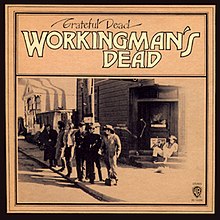Workingman's Dead
| Workingman's Dead | ||||
|---|---|---|---|---|
 |
||||
| Studio album by Grateful Dead | ||||
| Released | June 14, 1970 | |||
| Recorded | February 1970 | |||
| Studio | Pacific High Recording, San Francisco | |||
| Genre | ||||
| Length | 36:00 | |||
| Label | Warner Bros. | |||
| Producer |
|
|||
| Grateful Dead chronology | ||||
|
||||
| Professional ratings | |
|---|---|
| Review scores | |
| Source | Rating |
| Allmusic |
|
| American Songwriter | |
| Robert Christgau | A |
| Rolling Stone |
|
Workingman's Dead is the fourth Grateful Dead studio album. It was recorded in February 1970 and originally released on June 14, 1970. The album and its studio follow-up, American Beauty, were recorded back-to-back using a similar style, eschewing the psychedelic experimentation of previous albums in favor of Jerry Garcia and Robert Hunter's Americana-styled songcraft.
In 2003, the album was ranked number 262 on Rolling Stone magazine's list of the 500 greatest albums of all time.
The band again recorded at Pacific High Recording Studio in San Francisco, spending just nine days there. After the protracted sessions required for the previous two studio albums, Garcia suggested "Let's do it all in three weeks and get it the hell out of the way". Besides trying to avoid the debt that had accumulated while recording Aoxomoxoa, the band was dealing with the stress of a recent drug bust in New Orleans – which could have resulted in jail time. Additionally, they returned from a tour to find their soon-to-be-fired manager, Lenny Hart (father of drummer Mickey Hart), refusing to show the books to anyone else in the organization. "In midst of all this adverse stuff that was happening ... [recording the album] was definitely an upper," said Garcia in an interview.
Lyricist Robert Hunter had joined the band on the road for the first time, resulting in a period of faster song development. Unlike the psychedelic, electrified music for which the band had become known, the new songs took a new direction, reviving their folk-band roots. Bassist Phil Lesh stated "The song lyrics reflected an 'old, weird' America that perhaps never was ... The almost miraculous appearance of these new songs would also generate a massive paradigm shift in our group mind: from the mind-munching frenzy of a seven-headed fire-breathing dragon to the warmth and serenity of a choir of chanting cherubim. Even the album cover reflects this new direction: The cover for Aoxomoxoa is colorful and psychedelic, and that of Workingman’s Dead is monochromatic and sepia."
...
Wikipedia
